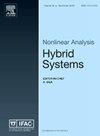H2 dynamic output feedback control of phase-type semi-Markov jump linear systems
IF 3.7
2区 计算机科学
Q2 AUTOMATION & CONTROL SYSTEMS
引用次数: 0
Abstract
This paper deals with the design of dynamic output feedback controllers for phase-type distributed semi-Markov jump linear systems. It is assumed that the state-space of the semi-Markov jump process can be written as the union of disjoint sets, called clusters, and that the only information available to the controller regarding the jumping process is which cluster it belongs to. We provide two sets of design conditions for the control problem, written in terms of bilinear matrix inequalities, which are associated with the observability and controllability Grammians (referred to as the “primal” and “dual” approaches, respectively). An iterative separation procedure, formulated as a sequence of linear matrix inequalities optimization problems, is proposed to reduce an upper bound of the norm of the system for both the primal and dual design conditions. We show that our conditions are not conservative in the sense that, for the Markov mode-dependent case, they also become necessary. Finally, we study the robust case, considering that the system matrices and transition rate matrix have polytopic uncertainties, and the observer-based control case, for which the conditions can be simplified and written directly as linear matrix inequalities. The paper concludes with an illustrative example in the context of systems subject to actuator and sensor faults.
相位型半马尔可夫跳变线性系统的H2动态输出反馈控制
研究了相位型分布半马尔可夫跳变线性系统H2动态输出反馈控制器的设计。假设半马尔可夫跳跃过程的状态空间可以写成不相交集的并集,称为簇,并且控制器关于跳跃过程的唯一信息是它属于哪个簇。我们为H2控制问题提供了两组设计条件,用双线性矩阵不等式表示,它们与可观察性和可控性语法(分别称为“原始”和“对偶”方法)相关。提出了一种迭代分离程序,将其表述为线性矩阵不等式优化问题序列,以降低系统在原始和对偶设计条件下H2范数的上界。我们证明了我们的条件在某种意义上不是保守的,对于马尔可夫模相关的情况,它们也是必要的。最后,考虑到系统矩阵和转移率矩阵具有多面体不确定性,研究了鲁棒情况和基于观测器的控制情况,其控制条件可以简化为线性矩阵不等式。最后,本文给出了一个执行器和传感器故障的系统实例。
本文章由计算机程序翻译,如有差异,请以英文原文为准。
求助全文
约1分钟内获得全文
求助全文
来源期刊

Nonlinear Analysis-Hybrid Systems
AUTOMATION & CONTROL SYSTEMS-MATHEMATICS, APPLIED
CiteScore
8.30
自引率
9.50%
发文量
65
审稿时长
>12 weeks
期刊介绍:
Nonlinear Analysis: Hybrid Systems welcomes all important research and expository papers in any discipline. Papers that are principally concerned with the theory of hybrid systems should contain significant results indicating relevant applications. Papers that emphasize applications should consist of important real world models and illuminating techniques. Papers that interrelate various aspects of hybrid systems will be most welcome.
 求助内容:
求助内容: 应助结果提醒方式:
应助结果提醒方式:


